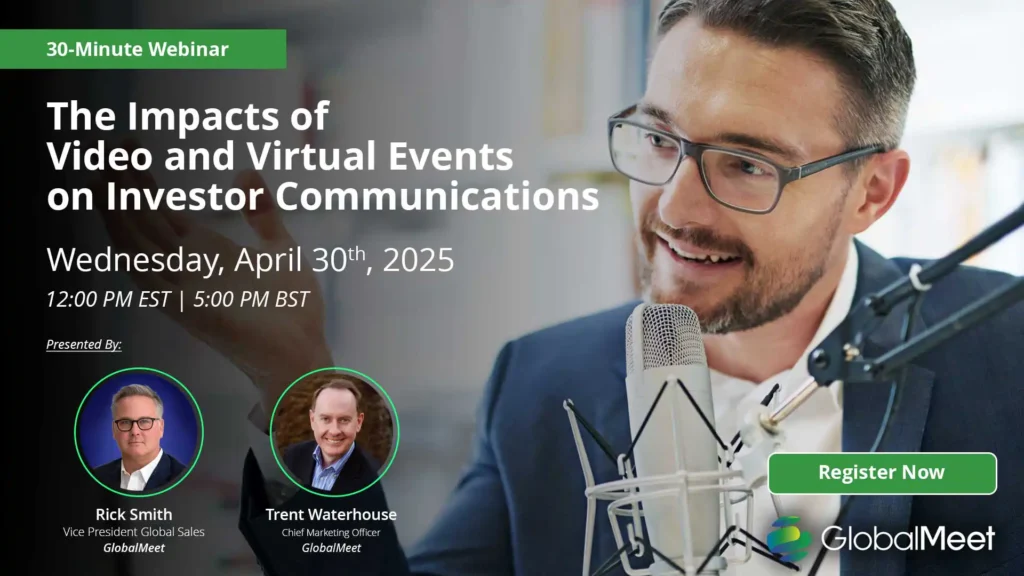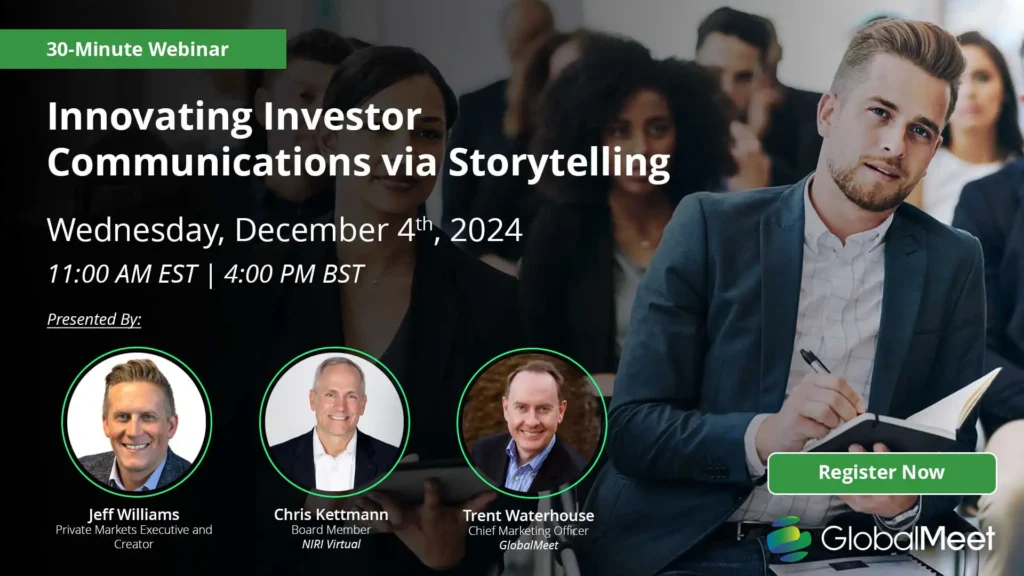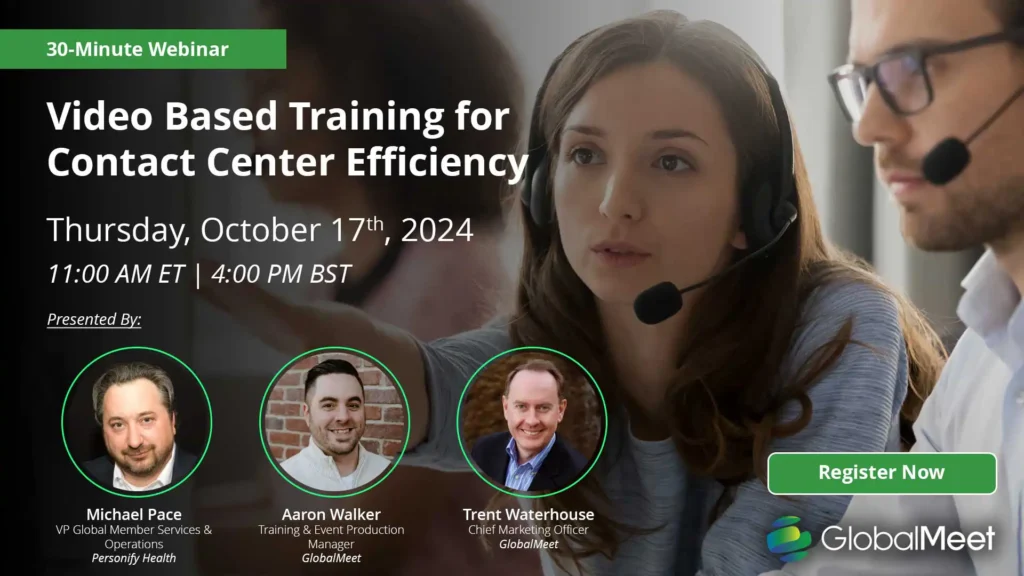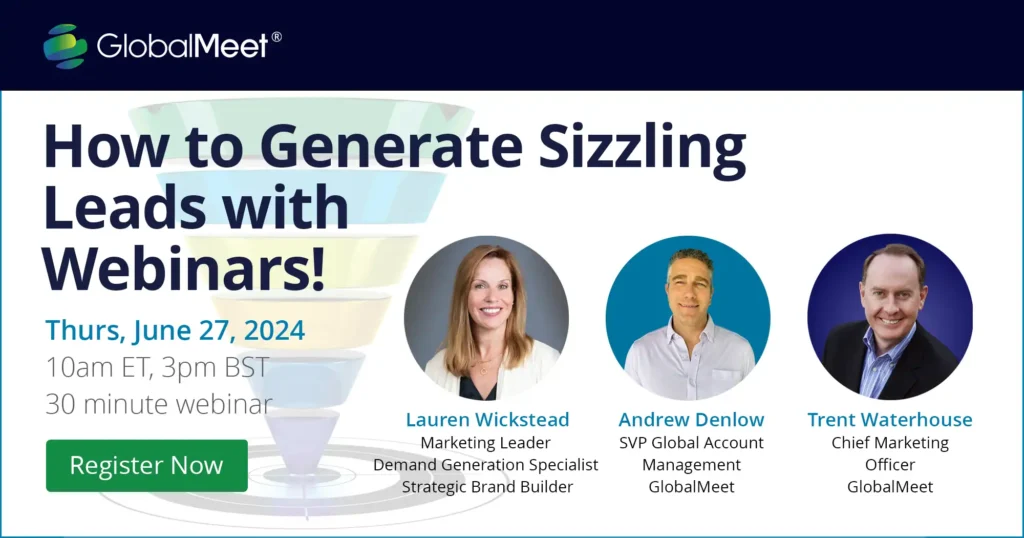
Webinar Platform Best Practices: Tips for Hosting Webinars
- by GlobalMeet Blog Team
- ,
Webinars have emerged as a powerful tool for engaging with audiences, generating leads, and sharing valuable insights. But we’ve all been to an underwhelming webinar—the kind of webinar that serves as a good excuse to put off your workload a little longer, but that’s about all you get from it. You don’t want your audience underwhelmed or overwhelmed—or any kind of whelmed, really.
So how do you maximize your webinar’s impact?
Below, we’ve broken down the best practices for hosting a webinar, and how to best leverage the opportunity. From choosing the right webinar platform to fostering a captivating presentation and following up with your audience, we’ll cover everything you need to know about hosting an effective virtual event.
What is a Webinar Platform?
A webinar platform is a specialized type of online service that enables businesses and individuals to host live, interactive events over the internet. These platforms are designed to simulate a real-life conference or seminar experience, providing tools for presentations, audience engagement, and communication. The main difference for attendees is that they don’t have to put on a suit or wear a lanyard badge.
Key Takeaways:
- Webinar platforms are specialized software or services for hosting web-based seminars.
- They offer tools for content creation, real-time interaction, and session recording.
- Features include registration management, scheduling, and detailed analytics.
- Webinars are versatile tools for education, promotion, and communication.
GlobalMeet’s webinar platform, for instance, exemplifies this technology, and serves as a robust and reliable solution for virtual event hosting. It caters to various industries and use cases, making it a versatile choice for organizations of any size. With features such as live streaming, audience interaction tools, and customizable event spaces, GlobalMeet’s platform offers a dynamic and engaging experience for both hosts and participants.
We’ll get into the key strengths of GlobalMeet webinar services a bit later—we don’t want this to feel like one of those recipe blogs where the only thing you need is all the way down at the bottom. So let’s dive into why you’re here—the meat and potatoes.
Best Practices for Hosting Webinars
Each stage of a webinar is crucial in its own right, requiring careful planning and execution to ensure a seamless and impactful experience. From understanding your audience and selecting the right topic to engaging with participants live and effectively following up post-event, these insights will guide you through every step of the process. Whether you’re a novice or a seasoned host, these guidelines will equip you with the knowledge and tools to make for a much more remarkable event.
Before the Webinar: “Don’t Worry, You’ve Got Plenty of Time”
- Understand your audience thoroughly through research and personas.
- Choose a relevant topic aligned with audience interests and current trends.
- Craft content with striking visuals, storytelling, and insights.
First and foremost, understanding your audience is paramount. Your audience is the driving force behind any webinar’s success. Invest time in comprehensive research to gain insights into their needs, preferences, and pain points. Developing audience personas can be instrumental in this process, allowing you to delve into their demographics, industry sectors, and specific challenges your webinar can address. By knowing your audience inside out, you can tailor your content and presentation style to resonate with them effectively, making your webinar more valuable.
Choosing the right topic for your webinar is equally pivotal. Your topic should not only align with your audience’s interests but also provide substantial value. You can’t just do a webinar on puppies because you feel like it, although—not a bad idea altogether…
Stay attuned to industry trends and emerging challenges, and consider conducting surveys or polls to gauge your audience’s preferences. Addressing current issues or offering practical solutions can significantly enhance the appeal of your webinar. The aim is to select a topic that not only educates but also captivates your audience’s interest, ensuring that they find the content compelling and worth their time.
Once you’ve identified your audience and chosen a relevant topic, it’s time to delve into content preparation. Engaging content forms the heart and soul of a successful webinar. Incorporate visual aids such as slides, videos, and images to enrich your presentation visually. Storytelling can be a potent tool to make your content relatable, resonating with your audience on a personal level.
To ensure that your content meets your audience’s expectations, focus on delivering actionable insights and valuable takeaways. Well-prepared content sets the stage for an interactive and impactful webinar, setting you up for success in your virtual communication endeavors.
During the Webinar: “Holy Moly, You Don’t Have Plenty Of Time”
- Use interactive elements like polls, quizzes, and Q&A sessions.
- Schedule the webinar strategically, considering global time zones.
- Keep the webinar within a 30 to 50-minute time frame for engagement.
- Create a custom landing page for a positive first impression.
Once your webinar is live, it’s crucial to implement best practices to ensure it runs smoothly and captivates your audience effectively. Interactive elements are your allies during the webinar. Features like polls, quizzes, and Q&A sessions can make your presentation more engaging and dynamic. Polls are a fantastic way to gauge your audience’s thoughts and engage them right from the start. Interactive quizzes add an element of fun and competition, keeping your audience invested in your content. The Q&A session allows real-time interactions, making participants feel included and part of the conversation. These interactive elements not only enhance engagement but also provide valuable insights into your audience’s preferences and understanding.
Scheduling your webinar strategically is another key consideration during the live event. Given that your audience might be spread across different time zones, aim for midday sessions that are reasonable for a global audience. Keeping the webinar within a 30 to 50-minute timeframe is advisable to maintain engagement levels. Lengthy sessions can lead to audience fatigue and diminish the overall impact of your content. It’s also vital to allocate time carefully, ensuring smooth transitions between topics and preventing abrupt endings that could leave attendees dissatisfied.
Creating a custom webinar landing page can significantly impact the audience’s perception during the live event. Your landing page serves as the first point of contact between you and your participants, setting the stage for what they can expect. Clearly display the date, time, and topic of your webinar to help attendees plan accordingly. A concise description of the content and its relevance can pique interest and draw potential participants. Think of your landing page as a sneak peek into the value you’re about to deliver, igniting curiosity and engagement. During the live webinar, this landing page serves as a virtual doorstep that welcomes attendees and sets a positive tone for the entire event.
After the Webinar: “Phew, That’s Over—But You’re Not Done!”
- Implement post-webinar strategies, such as follow-up emails with valuable content.
- Share the recorded session for accessibility and engagement.
- Collect attendee feedback through surveys.
- Foster a sense of community among participants through social platforms and forums.
Your webinar might have concluded, but the engagement doesn’t end there—you don’t go on a lovely date and never call them again, do you? No, you follow up like the Casanova you were born to be.
The post-webinar phase is just as crucial for maintaining connections and deriving additional value from your efforts. One of the most effective post-webinar strategies is sending follow-up emails. These emails should offer more valuable content related to the webinar topic, such as articles, templates, or additional resources. By doing this, you reinforce the knowledge participants gained during the webinar and demonstrate your commitment to providing ongoing value. These follow-ups also serve as an opportunity to express gratitude for attendees’ participation and feedback.
Additionally, it’s essential to share the recorded version of your webinar. Some participants might have missed the live event due to scheduling conflicts, and others may wish to revisit the content. Providing access to the recorded session ensures that your valuable insights remain accessible to a broader audience.
Furthermore, consider sending out surveys to your attendees to gather feedback. Ask them what they liked, areas for improvement, and topics they’d like to see in future webinars. This feedback is invaluable for refining your future webinar strategies and tailoring content to your audience’s preferences, ultimately enhancing engagement.
Beyond individual follow-ups and content sharing, consider fostering a sense of community among your webinar participants on social media and other platforms. Post “snackable” content about the event or related topics, enticing the participants—or even those who missed out—to dive back into the funnel.
Encourage them to connect on social media platforms or dedicated forums related to your webinars. This engagement enables participants to continue discussions, share ideas, and network with like-minded individuals. Building a community around your webinars not only keeps attendees engaged but also strengthens their loyalty to your brand or organization. It creates an ongoing conversation that extends beyond the webinar itself, providing participants with a platform to interact and learn from one another.
The Importance of Engaging Webinars
Hosting engaging webinars is essential in a world flooded with information and virtual events. Webinars bridge geographical gaps, bringing people together to connect, learn, and interact in an exciting and interactive manner. They offer numerous benefits, including increased audience engagement, brand loyalty, lead generation, and more targeted communication. By embracing these practices, you can harness the full potential of webinars and elevate your communication and education efforts.
- Audience Retention: Engaging webinars keep attendees’ attention, ensuring they stay for the entire presentation.
- Knowledge Transfer: Engagement enhances the conveyance and comprehension of information, promoting learning.
- Interactivity: Engaged audiences interact, ask questions, and contribute, creating a dynamic and informative experience.
- Positive Brand Impact: Well-executed webinars enhance brand reputation, potentially leading to increased conversions and audience loyalty.
Hosting Webinars with GlobalMeet: A Comprehensive Overview
Ease of Access and Reliability
GlobalMeet’s webinar platform is designed for effortless access, with no downloads or plugins needed, ensuring a smooth experience for all users. It’s mobile-friendly and has been calming the nerves of event organizers for over two decades with its reliable, browser-based access.
Scalability and Security
Whether you’re hosting a small seminar or a large-scale event, GlobalMeet can effortlessly accommodate up to 100,000+ live streaming attendees. The platform also prioritizes security, offering multiple protective measures such as password protection, email and domain authorization, and single sign-on options.
Engagement and Support
Engagement is key in webinars, and GlobalMeet offers a suite of interactive features like Q&A sessions, polls, surveys, and live chats. The platform also boasts robust analytics for post-event insights. Plus, with round-the-clock support and extensive training resources, even newcomers to virtual events can host with confidence.
By following these tips, choosing the optimal platform, and performing the appropriate amount of planning and research, you can be sure your next webinar event is more memorable than forgettable, and more remarkable than regrettable. Looking to get the ball rolling? Watch a demo or contact the GlobalMeet team today!

Virtual Meetings vs. Virtual Events: Choosing the Right Platform for Your Needs
- by GlobalMeet Blog Team
- ,
Whether we like it or not, in-person gatherings are few and far between, and workforces are becoming more and more spread out. Today, virtual formats reign supreme, offering flexibility, accessibility, and cost-effectiveness. But with this evolution comes a new question for event planners: virtual meetings or virtual events? Which one makes more sense, and when? Let’s dive in and explore the key differences to ensure you select the perfect platform for your needs.
Understanding Virtual Meetings: A Collaborative Cornerstone
Virtual meetings are the lifeblood of many remote teams, fostering real-time business communication and collaboration even when team members are scattered across the globe. These meetings, conducted through video conferencing or online meeting software, provide a virtual “meeting room” experience.
This allows teams to conduct interactive discussions, share presentations and documents, and brainstorm ideas together in real time. Virtual meetings, when organized properly, are perfect for status updates, project check-ins, client calls, candidate interviews, and a variety of other scenarios where a focused group needs to come together and achieve a specific goal.
Exploring Virtual Events: A World of Possibilities
Virtual events, however, take communication and engagement to a whole new level. They extend far beyond the simple functionality of a virtual meeting, offering a dynamic and immersive experience for much larger audiences. Imagine replicating the energy and excitement of a conference, complete with keynote speakers, engaging content and live Q&A, —all within a virtual environment.
But that’s not all. Virtual events open doors to a world of creative possibilities. Livestream product launches, town halls, HR updates, or interactive and certified training sessions—the options are virtually (no pun intended) limitless. Think customizable registration pages, interactive lobbies, gamification elements, and built-in social networking features—all designed to keep your attendees engaged from the moment they log in.
Key Differences Between Virtual Meetings and Virtual Events
While both virtual meetings and virtual events play a vital role in today’s business landscape, some key distinctions will help you choose the right platform:
- Scale and Audience Size: Virtual meetings are ideal for smaller, collaboration groups. Virtual events, on the other hand, can accommodate thousands of attendees simultaneously.
- Planning and Organization: Virtual meetings require minimal planning, while virtual events involve a more complex orchestration of speakers, sessions, content, and attendee engagement.
- Interactivity and Engagement: Virtual meetings offer basic interaction features like chat and screen sharing. Virtual events leverage a wider array of tools—polls, Q&A sessions, live chats and certifications, —to keep attendees engaged and foster a dynamic online community.
- Session Variety and Content Delivery: Virtual meetings typically revolve around a single agenda or presentation. Virtual events offer a much richer tapestry of content, including keynote addresses, panel discussions, workshops, and pre-recorded sessions.
Distinct Use Cases for Virtual Meeting and Virtual Event Platforms
So, when should you be looking to utilize virtual meetings, and when should you go with a virtual event? Sometimes it can be tough to tell—here’s a breakdown of some of the most common use cases for each type of platform:
Virtual Meeting Platform Use Cases
Daily Team Stand-Ups and Project Check-Ins
Kick off your day with a quick virtual meeting to keep everyone on the same page, discuss priorities, and identify any roadblocks.
Client Calls and Pitches
Connect with clients face-to-face without the hassle of travel. Deliver impactful presentations, share proposals, and answer questions in real-time.
Remote Onboarding and Training
Welcome new hires into the fold with interactive virtual onboarding sessions. Provide ongoing training and development opportunities for your team members, regardless of location.
Brainstorming Sessions and Creative Collaboration
Generate innovative ideas and solutions through collaborative brainstorming sessions. Share screens, whiteboards, and documents to fuel creative thinking.
Interviewing and Candidate Selection
Conduct efficient and effective interviews with top talent from around the world. Evaluate skills, experience, and cultural fit through virtual interactions.
Virtual Event Platform Use Cases
Town Hall Meetings
Livestream company updates, conduct live Q&A sessions with leadership, and leverage polls and surveys to gather real-time employee feedback.
Investor Relations
Host virtual investor events, share financial updates through live presentations, and facilitate interactive Q&A sessions to address investor concerns.
Demand Generation
Lead captivating virtual product launches, conduct interactive webinars with industry experts, and showcase your solutions at virtual tradeshows.
Human Resources
Onboard new hires and offer ongoing training and development opportunities for your team through interactive virtual workshops and seminars.
Continuing Education
Expand your reach and open access to education with virtual learning experiences. Issue online courses, workshops, and certification programs for a global audience.
Virtual Tradeshows
Conduct product demos and generate leads through targeted marketing campaigns and virtual booths.
Choosing the Right Platform: Virtual Meeting or Virtual Event
Now that you understand the core differences, how do you decide which platform to use? Here’s a guiding principle:
- Virtual Meeting Platforms: Opt for a virtual meeting platform when you need to connect smaller teams for collaborative discussions, brainstorming sessions, quick catch-ups, client calls, interview candidates, or project check-ins. These platforms are ideal for day-to-day business communication and internal teamwork.
- Virtual Event Platforms: When your vision involves a large-scale audience, multi-session agendas, high levels of engagement, and a broader range of content delivery formats, virtual event platforms are most ideal. With a comprehensive suite of features—from pre-event promotion and registration to live event execution and post-event analytics—you’ll offer a much more robust and fruitful experience than a simple virtual meeting.
Understanding the distinctions between virtual meetings and virtual events empowers you to make informed decisions when planning your next online gathering. By aligning your platform choice with your specific objectives, you can create impactful and successful virtual experiences that leave a lasting impression on your audience.
At GlobalMeet, we’re passionate about helping you unlock the full potential of virtual events. Contact us today or watch a demo now and see how GlobalMeet can transform your next virtual event into an extraordinary success!

Navigating Corporate Event Management Software: A Comprehensive Guide
- by GlobalMeet Blog Team
- ,
Corporate events aren’t quite as stuffy as they used to be, huh? Today, they play a pivotal role in fostering brand awareness, building relationships, and driving key objectives—all critical components to running an impactful operation. However, the planning and execution process can often be a labyrinth in and of itself, one that even David Bowie would have trouble navigating. This is precisely where event management software comes into play—the planning and execution, that is. Not with defeating goblin kings. You’re on your own there.
This guide delves into the complex world of enterprise event management software, equipping you with the knowledge to take full advantage of its functionalities and unlock its potential for success. We’ll explore the core features, delve into strategic considerations for selection, and illuminate how this technology empowers you to craft exceptional events. Sound like a plan? Ready… break!
What is Corporate Event Management Software?
Corporate event management software is a comprehensive tool designed to facilitate the planning, organization, and execution of corporate events both hybrid or totally virtual. It streamlines processes such as attendee registration, schedule management, engagement tracking, and more.
This software is crucial for businesses aiming to efficiently manage events, from small meetings and town halls to large conferences and tradeshows. It ensures a seamless event experience for both organizers and attendees, enabling effective communication, data analysis, and integration with other business tools.
Enterprise event management software aligns with the phases of hosting a virtual or hybrid event by providing tools and features for each step of the event lifecycle. From the planning phase, where it assists with scheduling and registration, to the execution phase, offering functionalities for live streaming and engagement—such as polls or chats—and finally to the post-event phase, facilitating feedback collection and analytics.
What Are the Key Features of a Robust Event Management Software Platform?
The optimal enterprise event management platform depends heavily on its features. It can be affordable, sleek, and easy to use all day long, but that’s all for nothing if it can’t handle the bells and whistles portion to do what you need it to do. So what are the most important features you and your team should be looking for in a corporate event management system? Just in case you don’t already have them listed out, we went ahead and did it for you:
Core Functionalities
- Registration: Streamline guest access, with an easy to use branded registration page.
- Agenda Management: Create agendas, schedule sessions, and integrate speaker bios and presentations for a cohesive experience.
- Communication Tools: Utilize built-in features to send targeted email campaigns such as reminders and follow-up emails.
- Engagement Features: Foster audience participation with live polls, Q&A sessions, social media integration, and other interactive elements.
- Analytics and Reporting: Gain valuable insights through robust analytics that track attendee behavior, measure event success, and inform future planning.
Design-Centric Features
- Event Format Flexibility: Cater to the evolving event landscape by supporting virtual and hybrid events seamlessly.
- Scalability and Adaptability: Accommodate an increasing number of attendees or handle more complex events as your needs grow.
- Integration Capabilities: Integrate with existing tools like CRM or marketing automation platforms to streamline workflows and eliminate data silos.
- Customization Options: Personalize the event experience by incorporating your brand identity and tailoring attendee communications.
Additional Capabilities
- User-Friendly Interface: Offer an intuitive interface for both event organizers and attendees to ensure ease of use.
- Content Delivery Options: Seamlessly handle live presentations, pre-recorded sessions, or on-demand resources to cater to diverse learning styles.
- Advanced Analytics: Go beyond basic metrics to gain deeper insights into attendee behavior and preferences to inform future content strategy and event design.
Other Key Considerations
- Security Features: Ensure the platform adheres to industry-standard security protocols to protect sensitive data.
- Customer Support: Evaluate the quality and accessibility of customer support offered by the software vendor.
- Pricing and Scalability: Compare pricing models and ensure the platform’s scalability aligns with your anticipated growth trajectory.
Choosing the Right Corporate Event Management Partner
Selecting the ideal corporate event management software hinges on a clear understanding of your specific needs and objectives. Without clarifying these things, you might be up a creek without a paddle. And that’s never fun. It involves a lot of mud, to say the least. Anyway, here are crucial factors to consider when navigating the selection process to help you evaluate how the system aligns with your needs:
What are the Event Goals?
Evaluate the software’s capabilities against your event’s objectives. Does it offer the features necessary to achieve your desired outcomes, be it audience engagement, brand awareness, or lead generation?
Who is the Target Audience?
Consider the demographics and technological savviness of your attendees. Choose a user-friendly platform with features that cater to their needs and preferences.
What Sort of Scalability and Flexibility Might You Need?
Ensure the platform can adapt and grow alongside your events. Opt for software that can accommodate an increasing number of attendees or handle more complex events in the future.
What Integration Capabilities Do You Need?
Seamless integration with existing tools like your CRM or marketing automation platform can streamline workflows and eliminate data silos.
Do You Require Specific Customization?
Does the platform enable you to personalize the event experience? Look for features that allow you to incorporate your brand identity visually and tailor attendee communications.
Building Your Event Tech Ecosystem
Enterprise event management software forms the core of your event tech stack, but its true potential is amplified when it’s combined with other specialized tools. Here’s how to curate a comprehensive tech ecosystem for a seamless event experience:
- CRM Integration: Integrate your event software with your CRM to gain a 360-degree view of attendees. This allows for targeted marketing campaigns, personalized event experiences, and improved lead nurturing.
- Marketing Automation Synergy: Sync with your marketing automation platform to streamline pre-event communication, nurture leads, and trigger targeted post-event follow-up campaigns.
- Engagement Boosters: Consider incorporating interactive tools like live polling apps, gamification platforms, or social media walls to enhance audience participation and create a more dynamic event environment.
- Event App Power: Explore the potential of a custom event app to provide attendees with easy access to agendas, speaker information, networking opportunities, and real-time event updates.
By strategically integrating these additional tools with your core event management software, you can orchestrate a symphony of technologies that empowers you to deliver exceptional events.
Optimizing Your Partnership: Maximize The Software Potential
Once you’ve shopped the marketplace, selected your event management software partner, harnessed the software’s features, and built your tech stack, there’s still some leftover juice to squeeze. Here are some success strategies to consider to best utilize your new corporate event software system:
- Invest in Training: Equipping your team with comprehensive training on the software’s functionalities ensures everyone can leverage its full potential.
- Professional Guidance and Management: The leaders in corporate event management will often provide professional guidance and co-management of your virtual or hybrid events.
- Content is King: Remember, even the most feature-rich software cannot compensate for lackluster content. Focus on developing engaging presentations, workshops, and other materials that resonate with your audience.
- Embrace Feedback: Utilize the software’s built-in analytics and feedback tools to gather valuable post-event insights. Analyze attendee responses to identify areas for improvement and continuously refine your event planning strategies.
GlobalMeet: Streamlining Your Corporate Event Management
At GlobalMeet, we understand the complexities of corporate event planning. That’s why we created a user-friendly corporate event management software solution designed to streamline every step of the process, from registration to post-event analysis. Our platform empowers you to manage both virtual and hybrid events with ease, ensuring a seamless and engaging experience for all participants.
Create Memorable Events
GlobalMeet’s intuitive interface allows you to effortlessly manage registrations, schedule sessions, and craft compelling agendas. Built-in communication tools keep attendees informed throughout the event lifecycle, while interactive features like live polls and Q&A sessions foster engagement and keep audiences captivated. But we know that numbers don’t lie. That’s why we provide robust analytics that helps you measure event efficacy and refine your strategies for future events.
Flexibility and Scalability
The event landscape is constantly evolving. With GlobalMeet, you have the flexibility to adapt. Our software supports virtual and hybrid events, ensuring you can reach your target audience regardless of location. And as your organization grows, so too can your event management capabilities. GlobalMeet is built to scale, accommodating an increasing number of attendees and handling more complex events with ease.
Impart Brand Identity
We understand that every event is unique. That’s why GlobalMeet offers customization options. Incorporate your brand identity visually throughout the platform, from registration pages to email communications. This personalized experience fosters stronger connections with attendees and reinforces your brand message.
GlobalMeet's Platform Includes:
- Scalability: Broadcast high-quality video to large audiences globally.
- On-Demand Viewing: Record and store webcasts for unlimited access by attendees.
- Customization: Tailor the entire event experience to your brand, from registration pages to live sessions.
- Engagement Tools: Foster audience participation through features like polling, Q&A, and social media integration.
- Security: Maintain enterprise-grade security with features like password protection and access control.
- Accessibility: Break down language barriers with live interpretation or captioning.
- Analytics: Gain valuable insights into event performance through real-time data reporting.
- Compliance: Support adherence to strict regulations like GDPR.
- Professional Services: Receive expert assistance with event planning, management, and execution.
- Subscription Plans: Choose a plan that caters to your event size and needs.
- Integrations: Integrate with existing marketing automation or CRM platforms.
Elevate Your Event with GlobalMeet's Managed Services
Planning a virtual or hybrid event for your company can be daunting—GlobalMeet’s professionally managed services take the weight off your shoulders. Our expert team acts as an extension of yours, handling everything from concept development to flawless execution.
- Expert Planning & Logistics: We meticulously manage logistics, speaker coordination, and content curation, letting you focus on core objectives.
- Tech Integration & Engagement: Our specialists ensure seamless integration with your chosen platforms and craft engaging audience interaction strategies using live polls, Q&A, and chat features.
- Real-Time Support & Reporting: Rest assured, our team is there throughout the event, providing support and troubleshooting. We also offer post-event analysis and reporting to help you refine future events.
We offer tiered service options to match your event complexity and team bandwidth. Choose the level of support that best suits your needs, from specific areas like logistics to a full-service event management solution.
Hosting Seamless Virtual and Hybrid Events
Imagine hosting a global conference where remote attendees can participate just as actively as those in the physical venue. With GlobalMeet’s corporate event management software, you can leverage features like live streaming, breakout rooms for virtual attendees, and real-time chat functionalities to create a unified experience.
Additionally, our analytics provide insights into virtual audience engagement, allowing you to refine your approach and ensure a truly seamless event for all participants. By utilizing GlobalMeet’s comprehensive toolkit, enterprises can bridge the physical and virtual divide, fostering meaningful connections and maximizing the impact of their events.
Ready to embark on your event planning transformation? Get in touch with our experts or watch a demo today.

How to Plan a Virtual Event: A Step-by-Step Guide
- by GlobalMeet Blog Team
- ,
So you want to host a virtual event, huh? Perfect! But let’s not put the cart before the horse here—first, we have to actually plan the thing.
In this guide, we’ll explore the essentials of building a strong event team, creating engaging content and agendas, and the crucial steps of technical and rehearsal planning. From preparing presenters to finalizing event settings, this guide is designed to equip you with the necessary tools and insights for a successful virtual event.
Sound like a lot? Good, it should. A good virtual event isn’t just thrown together, even by professionals—like us here at GlobalMeet. After all, do you want to know how to plan a virtual event or how to plan a virtual event that people will love?
Let’s start out by clarifying the difference between virtual events and hybrid events, just to make sure we’re on the same page. Then, we’ll dive head first into the step-by-step guide on how to plan a virtual event.
Understanding Virtual vs. Hybrid Events
Virtual Events: The Digital Stage
Virtual events occur entirely online, accessible globally to anyone with an internet connection. These digital gatherings range from simple live streams to elaborate multi-day conferences with live speakers and breakout sessions. Their strength lies in inclusivity—reaching people irrespective of location, physical ability, or financial constraints. They offer a cost-effective, sustainable format, free from geographical limitations, and provide rich opportunities for data collection and brand awareness. Crucially, virtual events cater to diverse needs, from educational webinars to interactive social networking sessions.
Hybrid Events: Best of Both Worlds
Hybrid events blend in-person and virtual experiences, offering parallel participation whether attendees are on-site or joining remotely. Successful hybrid events ensure that both in-person and virtual attendees engage with the content equally, participate in discussions, and experience the event cohesively. These events are particularly effective for broad-reaching activities like industry-specific conferences, product launches, or educational seminars, where the aim is to combine the authenticity of face-to-face interactions with the wide reach of digital platforms.
Choosing the Right Format
The choice between virtual and hybrid formats hinges on your event’s objectives and audience. Virtual events are ideal when aiming for broad, global outreach or when logistics and budget constraints limit physical gatherings. Hybrid events shine in scenarios where you want to combine the intimacy and impact of in-person interactions with the extended reach of an online audience.
Embracing the strengths of each format allows you to tailor experiences that align with your goals, ensuring both engagement and effectiveness. Whether you choose the immersive world of virtual events or the dynamic blend of hybrid experiences, understanding these differences is key to planning successful, impactful events.
How to Plan a Virtual Event
Planning a virtual event requires a well-thought-out concept, and an even more meticulous plan of action. So below, we’ve broken down how to plan a virtual event into five basic steps.
- Building Your Event Team
- Creating Engaging Content and Agendas
- Technical and Rehearsal Planning
- Presenter Preparation and Coordination
- Finalizing Event Settings and Schedules
And there you have it: that’s how to plan a virtual event.
Alright, alright, there’s more to it. Here’s how we’ll elaborate: We’ll start by assembling a dynamic event team, each member playing a pivotal role in the event’s success. Then, we’ll delve into creating content that captivates and an agenda that keeps the audience engaged. Technical setup and rehearsals will ensure everything runs smoothly, while preparing presenters and fine-tuning event settings will lay the groundwork for a seamless experience. Each of these steps is integral, and we’ll explore them in detail to equip you with the tools for success.
Step 1: Building Your Virtual Event Team
A successful virtual event hinges on a well-coordinated team, each member playing a pivotal role in ensuring seamless execution.
Project Manager
The Project Manager is the backbone of your event, orchestrating the overall vision, timelines, and resources. They ensure that every aspect of the event aligns with strategic objectives, managing everything from initial planning to post-event analysis. Their role involves coordinating across various teams, resolving logistical challenges, and keeping the event on track.
Production Manager
The Production Manager is responsible for the technical aspects of the event. They work closely with the tech team to manage the platform, handle audio-visual elements, and ensure that all technical requirements are met. This role is crucial for troubleshooting technical issues and ensuring a smooth, glitch-free experience for participants.
Producer: The Live Event Conductor
During the event, the Producer takes the lead. They are responsible for the live execution of the event, managing the flow, transitions, and ensuring that each segment starts and ends on time. A great Producer can seamlessly blend different elements of the event, making the technology invisible to presenters and participants.
Content Coordinator and Marketing
The Content Coordinator oversees the event’s content, ensuring it is engaging, relevant, and well-paced. They work with speakers to fine-tune their presentations and align content with the event’s goals. The Marketing Team, on the other hand, drives awareness and attendance through strategic campaigns across various channels.
Step 2: Create Narrative Agendas and Compelling Content
Next On the Agenda: The Agenda
A well-structured agenda helps keep your audience engaged. Begin with a strong opening that captures attention, and space out your program to include a variety of sessions. Integrate interactive elements like live polls, Q&A sessions, and breakout rooms to foster attendee participation. Consider time zones for a global audience and keep sessions concise to maintain energy levels. Regular breaks are essential, especially for longer events, to prevent zoom fatigue. Close with a compelling session that leaves a lasting impression and encourages further engagement.
Gathering Speaker Materials
In the run-up to the event, ensure you collect all necessary materials from your speakers well in advance. This includes not only their presentation content but also bios, photos, and social media links. These elements are crucial not just for the event itself but also for promotional activities, helping to build anticipation and connect the audience with your speakers.
Crafting Effective Event Slides
If you want to know how to plan a virtual event and only remember one thing, make sure it’s this: the heart of a successful virtual event lies in its content.
Start by identifying the most impactful themes that resonate with your target audience. Incorporate a mix of formats—keynote speeches, panel discussions, interactive workshops—to maintain interest. Use storytelling to make presentations relatable and memorable. It’s crucial to include real-world examples, case studies, or live demonstrations to enrich the content. Ensure the content not only informs but also inspires and engages your audience.
A well-designed slide deck is more than just a visual aid; it’s a roadmap for your event. It should clearly outline the structure, maintaining a balance between information and engagement. Remember, the best slides complement the speaker, reinforcing their message without overshadowing it.
Optimizing Your Presentation Space
The physical space from where you present plays a subtle yet significant role. Ensure high audio quality with a good microphone or headset. Pay attention to your background—keep it clean and clutter-free. A messy backdrop will leave the attendees feeling icky. Same with your attire: dress in simple, solid colors to minimize distractions but portray professionalism and authority. This setup helps maintain focus on your content, ensuring your audience absorbs and trusts every word.
Incorporating these elements into your virtual event planning ensures a polished and professional experience, where every detail is aligned with your overarching goal of delivering an unforgettable virtual event.
Step 3: Technical and Rehearsal Planning
When it comes to virtual events, the devil is in the technical details. Ensuring a flawless technical setup is non-negotiable. This includes establishing robust broadcast channels for wider reach, such as Facebook Live, LinkedIn Live or YouTube, and hardwiring your internet connection for stability. A shaky connection is the quickest way to lose your audience’s attention and trust.
Equally crucial is the rehearsal process. Conducting at least one thorough rehearsal is essential to familiarize speakers with the presentation software and format. This dry run should replicate the live event conditions as closely as possible. Everyone involved should test their cameras, microphones, lighting, and any other equipment to iron out potential issues.
The webinar planning phase is also the perfect opportunity to practice transitions and content flow, ensuring that speakers feel confident and ready. Remember, a well-rehearsed event is more likely to run smoothly and keep your audience engaged from start to finish.
Step 4: Presenter Preparation and Coordination
Preparing your presenters is a critical step in the success of your virtual event. Begin by providing them with comprehensive best practices for using the webcast platform. It’s essential for presenters to be familiar with the technology to ensure a smooth delivery.
During rehearsals, focus on checking audio and video quality to ensure they are clear and professional. Encourage presenters to use the same technical setup during rehearsals as they will during the live event. A well-prepared presenter is confident and engaging, key to delivering a successful virtual session.
Step 5: Finalizing Event Settings and Schedules
- Configuring Webcast Software Settings: Ensure all technical aspects of the webcast software are properly set up. This includes audio and video settings, chat functionalities, poll creation, and other interactive features. It’s crucial to tailor these settings to suit the specific needs of your event.
- Scheduling Presenters: It’s vital to have presenters log in well before the event start time. Aim for a 30-60 minute early login to allow for any last-minute adjustments or troubleshooting. This window also provides an opportunity for presenters to acclimate to the virtual environment and interact with each other, fostering a more relaxed and confident presentation atmosphere.
- Final Checks and Balances:
Test all links and login credentials.
Verify that backup systems are in place for critical components.
Confirm that all content, such as slides and videos, is uploaded and functioning correctly.
By carefully managing these final steps, you can significantly reduce the risk of technical glitches and ensure a smooth, professional experience for both presenters and attendees. After you’ve successfully planned your virtual event, all that’s left to do is promote, execute, generate leads, and follow up!
In summary, when you’re exploring how to plan a virtual event, it involves five steps:
- Building Your Event Team: Assemble a team with roles like Project Manager, Production Manager, and Producer to ensure smooth coordination.
- Creating Engaging Content and Agendas: Develop captivating content and a well-paced agenda, balancing various session formats and incorporating interactive elements.
- Technical and Rehearsal Planning: Focus on technical setup, including stable internet connections and comprehensive rehearsals to familiarize speakers with the event format and technology.
- Presenter Preparation and Coordination: Prepare presenters with best practices and ensure they are comfortable with the technology and event format.
- Finalizing Event Settings and Schedules: Configure webcast software settings, schedule presenters for early arrival, and perform final checks for a seamless event.
Virtual Events with GlobalMeet
GlobalMeet stands as a premium solution, whether you’re organizing a simple event on your own or a complex, multi-day webinar requiring a full team. GlobalMeet provides access to a comprehensive event builder, a live event studio, and a range of customizable features.
We offer everything from self-service options with complete training to professionally managed events with expert event teams. Our platform is designed for various scenarios like corporate communications, investor relations, demand generation and more, ensuring an engaging and interactive experience for your audience.
See what the fuss is all about, and discover why five out of ten of the largest US banks trust GlobalMeet—watch a demo or contact us today!

5 Tips for Virtual Event Best Practices
- by GlobalMeet Blog Team
- ,
Whether delivering financial updates at a shareholder’s meeting, leading the launch of a new product, or educating customers about the latest product features, all great virtual events share a few common elements.
Integrating these key components into your virtual and hybrid events can help enhance audience engagement, your brand recognition, and encourage a bump in attendance at your next event. Moreover, a powerful virtual event can pay for itself in both sales and customer loyalty.
Now, the question arises: What are the the 5 best practices for virtual events to maximize your Return on Investment (ROI)?
1. Engagement through Interactive Features
Today’s virtual events must compete with in-person events with all the high-tech bells and whistles, combined with the opportunity for in-person chit-chat and networking. But virtual and hybrid events can be just as good as in-person gatherings if you implement the right tools.
A virtual event solution provides opportunities to reach even more people than an in-person event could, in even more compelling ways. To help your virtual event stand out, make sure you give your attendees plenty of chances to interact. Features like polling, Q+As and audience chat can set your event apart.
2. Add Creativity into Your Marketing Strategies and Presentations
Technology, of course, plays a key role in how compelling your virtual event can be. But you also want to put your most creative marketing minds in charge of promoting your event through email, social media, and other lead generation campaigns.
Collect presenter bios to benefit your marketing campaigns. Be sure to agree on the content they will share in advance of the event to generate buzz around the event. Consider interviewing one of the presenters in a recorded video to post on LinkedIn and other social channels.
3. Tailor Your Content for Targeted Audience Engagement
From your marketing campaigns to the event presentations, be sure every piece of content you develop speaks directly to your target audience. You’ll want to involve your sales and marketing teams to create an audience persona — your ideal customer who will be attending the event.
Then, show them what pain points they have that your virtual event can help them solve. It might help to poll your audience in advance via email to determine what features of your business they hope to learn more about. Then, you can tailor content to address those needs.
4. Highlight Your Brand Presence
Your marketing team and event planners will put a lot of time and manpower into creating content and producing an event that will speak directly to your audience. You want to make sure that your audience knows where all the valuable content comes from. It is important to focus on your branding before, during, and after the event.
GlobalMeet offers personalized branding for landing pages, the event itself, marketing resources and emails before and after the event. You can tailor your content to match your company’s branding guide, including the colors, fonts, logos, and design styles that are unique to your brand.
5. Conclude with a Clear Call to Action
When attendees exit your virtual event, they should be clear about their next steps. Your brand should be firmly embedded in their mind and think of your company as the industry expert in your field.
Be sure to leave audience members with a clear directive. Maybe you want them to buy a new product or add a feature to their Software-as-a-Service (SaaS) subscription. You can provide a limited-time-only discount code only for event attendees, so they can save money by purchasing within the next 48 hours. Whatever incentive you offer to your attendees, you want them to exit your virtual event with a clear idea of what they should do next.
Keep these five best practices for virtual events in mind when you produce your next webcast. GlobalMeet has all the tools you need to produce a great virtual event. Schedule a demo today to learn more.
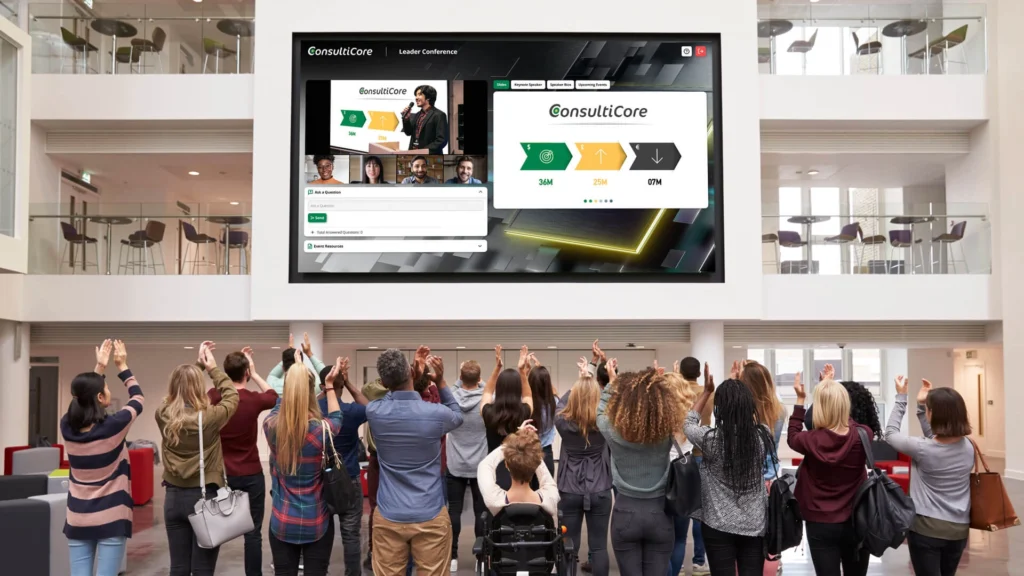
How to Host a Virtual Town Hall Meeting
- by GlobalMeet Blog Team
- ,
In today’s digital-first world, virtual town hall meetings have become a game-changer in corporate communication. They’re an ideal way to connect leadership with a distributed workforce, fostering a sense of community and transparency across any organization.
Whether you’re leading a Fortune 500 company or an emerging business, mastering the art of hosting effective virtual town halls can revolutionize your internal communications and align your teams with your company’s vision. Let’s dive into what makes these meetings tick, their benefits and how to host a virtual town hall meeting seamlessly with GlobalMeet.
In this comprehensive guide, we’ll cover:
- What are virtual town hall meetings?
- What goes on in virtual town halls?
- What are the benefits of virtual town halls?
- Virtual town hall agenda example
- How to host a virtual town hall meeting
- Town halls with GlobalMeet
What Are Virtual Town Hall Meetings?
A virtual town hall meeting is a digital evolution of the traditional town hall forum, adapted for the modern, interconnected corporate world. These meetings provide a virtual space where employees and management converge to exchange information, ideas and feedback. It’s a concept that transcends physical barriers, bringing together a dispersed workforce, from various departments and geographic locations, into a single, cohesive assembly.
The Dynamics of Virtual Town Halls
At its core, a virtual town hall is an interactive online event. Senior management and leaders utilize a virtual event platform to communicate company updates, policy changes and strategic directions. These meetings are designed for two-way communication. Employees are encouraged to engage in dialogues, pose questions and provide their insights, making these sessions an inclusive experience.
One of the unique aspects of virtual town halls is their ability to level the playing field. Unlike traditional in-person meetings where seating arrangements might create a hierarchy of visibility and engagement, virtual town halls offer every participant a ‘front-row’ experience. This setup fosters a sense of equality and encourages more open and balanced participation.
The Benefits of Going Virtual With Your Town Halls
Switching to virtual town halls offers several advantages over traditional, in-person gatherings:
- Cost-Effectiveness and Scalability: Virtual town halls eliminate the logistical challenges and costs associated with physical venues, travel, and accommodation. They are easily scalable, capable of accommodating anything from a small team to 100,000+ employees across the globe.
- Enhanced Engagement: Innovative digital tools, such as surveys, polling, Q&A, audience chat, social media feeds and dynamic layouts, transform passive listeners into active participants. These features enrich the experience and ensure higher engagement levels.
- Flexibility and Convenience: Participants can join from anywhere, be it their office, home, or on the move. This flexibility results in higher attendance and participation rates.
- Data and Feedback Collection: Virtual platforms enable the collection of valuable data, like engagement metrics and real-time feedback, helping organizations to gauge the effectiveness of their communication and make informed decisions for future meetings.
Incorporating GlobalMeet into Your Virtual Town Halls
While virtual town halls offer numerous advantages, their success heavily depends on the chosen platform’s capabilities. This is where GlobalMeet excels. Our platform is tailored to enhance your virtual town hall experience, providing advanced features and tools that make organizing and hosting these events straightforward and effective.
Whether you’re hosting a small internal meeting or a large-scale global event, GlobalMeet is equipped to handle your needs with ease. We offer robust security features to protect your discussions, flexible speaker options to accommodate multiple presenters and interactive elements to keep your audience engaged.
At GlobalMeet, we understand that every organization has unique needs. That’s why we offer both a webinar platform license and professionally managed event options, allowing you to choose the level of support that best fits your event.
What Goes On in Virtual Town Halls?
Virtual town halls are dynamic and multifaceted events that serve as a nexus for communication within an organization. Let’s break down the typical components and activities that make up these engaging digital assemblies.
Key Activities in Virtual Town Halls
Leadership Addresses
These meetings often commence with senior management, including CEOs and department heads, presenting the company’s current status, achievements, challenges and future plans. This segment sets the stage and provides context for the rest of the discussion.
Departmental Updates
Different departments or teams may present their updates, showcasing recent successes, ongoing projects, or future endeavors. This broadens employees’ understanding of the company’s diverse operations.
Interactive Q&A Sessions
A vital component of virtual town halls, Q&A sessions invite employees to ask questions via chat. With fully managed events, you can gain access to GlobalMeet’s Centerstage managed feature, where special guests cameo on video during a live event to ask a question or contribute to an ongoing discussion. This not only clarifies doubts but also fosters transparency and trust within the organization.
Polls and Surveys
Real-time polling and surveys are often conducted to gather instant feedback, gauge employee sentiments, or make collective decisions. This immediate interaction enhances engagement and makes employees feel valued.
Recognition and Awards
Acknowledging individual or team achievements during town halls boosts morale and motivates employees. It’s an opportunity to celebrate successes and reinforce positive behaviors aligned with company values.
Training and Development Opportunities
Sometimes, town halls include segments on professional development, where new training programs, learning resources, or career advancement opportunities are introduced.
Special Announcements
Virtual town halls are often used to make significant announcements such as mergers, acquisitions, or strategic shifts, ensuring that all employees receive this information instantaneously.
What are the Benefits of Virtual Town Halls?
Virtual town halls offer unique advantages that can significantly impact an organization’s communication strategy.
Enhanced Accessibility and Inclusivity
These meetings break down geographical barriers, allowing global participation. Employees from various locations can join, fostering a sense of unity and inclusion.
Data-Driven Insights for Improvement
With advanced analytics capabilities of platforms like GlobalMeet, organizations can gain insights into participant engagement and feedback, allowing for continuous improvement in their communication strategies.
Improved Communication and Transparency
Virtual town halls offer a platform for open dialogue between employees and management. This transparent communication helps in aligning the workforce with the company’s vision and goals.
Record and Replay Capabilities
Virtual town halls can be recorded, providing an opportunity for those who missed the live event to catch up, and for attendees to revisit key discussions.
Cost and Time Efficiency
By going virtual, companies save on the expenses and logistical complexities associated with physical events. This efficiency extends to attendees as well, who save time by joining from their preferred locations.
Interactive and Engaging Features
With tools like live polling, Q&A and chat functionalities, virtual town halls transform from passive listening experiences to interactive sessions.
Scalability and Flexibility
Whether it’s for a small team or an enterprise-wide gathering, virtual town halls can be scaled to fit any size, catering to hundreds or 100,000+ participants without compromising the quality of interaction.
Speak the Language of Your Customers, Investors and Employees
GlobalMeet builds an inclusive culture that breaks down language barriers, fosters team building and improves accessibility and inclusivity with live interpretations or captions during events.
In essence, virtual town halls, powered by robust platforms like GlobalMeet, are transforming corporate communication, making it more inclusive, engaging and effective. They are an indispensable tool in today’s fast-paced, globally dispersed corporate world.
Virtual Town Hall Agenda Example
Crafting an engaging agenda is key to a successful virtual town hall. Here’s an example agenda that leverages the capabilities of GlobalMeet’s solution.
Dynamic Kick-Off
- Introduction: Begin with a lively and engaging introduction. This could be a surprising fact, a thought-provoking question, or a brief, impactful story relevant to your organization’s current focus.
- Icebreaker Activity: Use GlobalMeet’s interactive features for a virtual icebreaker. This could be a quick poll, a fun trivia question about the company, or a creative visual puzzle to get everyone’s gears turning.
Company Insights and Updates
- Company Overview: Present an overview of the company’s recent achievements and current status. Utilize GlobalMeet’s high-quality video and slide-sharing capabilities to present engaging visuals.
- Departmental Highlights: Have department heads share their latest updates, achievements, and upcoming projects. This segment can include short video clips or interactive graphics to maintain audience interest.
- Milestone Celebrations: Acknowledge any significant company milestones, anniversaries, or awards, enhancing the sense of community and shared success.
Interactive Q&A Session
- Open Forum: Utilize GlobalMeet’s Centerstage Managed Feature to allow employees to ask questions on video. This session is moderated to ensure a smooth flow of conversation.
- Live Polling: Conduct live polls during the Q&A to gauge employee opinions on key topics or to make decisions on lighter, more engaging subjects.
Engaging, Accessible Activities
- Guest Speaker or Workshop: If applicable, include a segment with a guest speaker or a brief workshop on a topic of interest, such as mindfulness or professional development.
- Speak the Language: GlobalMeet’s language captions and live interpreters break down language barriers, fostering accessible, credible and effective global communication.
Forward-Looking Statements
- Future Goals and Objectives: Share the company’s vision for the upcoming quarter or year. This is an opportunity to align everyone with the organization’s future direction.
- Announcements of Upcoming Events: Inform the employees about upcoming events, training sessions, or town halls, creating anticipation and ensuring continued engagement.
Inspirational Conclusion
- Motivational Close: End the town hall on a high note. This could be a positive message from the CEO, a highlight reel of employee achievements, or an inspiring story that resonates with the company’s values.
- Feedback Request: Encourage participants to provide feedback on the town hall via GlobalMeet’s survey tool, emphasizing the importance of their opinions in shaping future meetings.
How to Host a Virtual Town Hall Meeting
Organizing a successful virtual town hall meeting can significantly impact your company’s internal communication and employee engagement. Here’s how to host a virtual town hall meeting that leaves a lasting impression on your audience.
- Establish Clear Goals
When it comes to hosting a virtual town hall meeting, defining your purpose is the first and crucial step. Are your goals centered around corporate updates, boosting employee engagement, or conveying strategic announcements? Understanding your audience is equally important. Determine whether you’re addressing the entire organization, certain departments, or a combination of internal and external stakeholders.
- Scheduling and Familiarization
Scheduling your virtual town hall meeting is a critical aspect, especially if your audience spans multiple time zones. Familiarize yourself with all the features that GlobalMeet offers, ensuring you leverage its full potential for effective streaming and engaging audience interaction.
- Content Preparation
A well-crafted agenda is essential for a successful virtual town hall. Outline all the topics and segments in your agenda and share them with attendees in advance. This approach sets clear expectations and helps in keeping the meeting structured. Conduct rehearsals for all speakers using GlobalMeet’s tools to ensure they are comfortable with both the technology and their content delivery.
- Technical Readiness
Make sure to conduct a thorough check of all technical elements, like audio and video quality, before the event. Preparing GlobalMeet’s interactive features such as Q&A, polling and chats in advance will enhance audience participation and engagement during the town hall.
- Execution of the Town Hall
Start your virtual town hall meeting punctually, respecting your attendees’ time. Engage your audience by utilizing GlobalMeet’s interactive tools and maintaining a dynamic and interactive presentation style. Adhering to the agenda is important, but remain adaptable to accommodate any real-time audience interactions or discussions that may arise.
- Post-Event Engagement
Post-event engagement is crucial. Share the recording of the town hall with those who couldn’t attend using GlobalMeet’s recording feature. Collecting feedback through surveys after the event is crucial in gathering insights to refine and improve future virtual town halls.
- Review and Improvement
Finally, review and improve your town hall meetings by analyzing engagement through GlobalMeet’s reporting and analytics. Understanding attendee behaviors and engagement levels is key. Use the feedback and data insights you collect for continuous improvement, ensuring each virtual town hall is more impactful than the last.
Learning how to host a virtual town hall meeting involves careful planning, leveraging the right tools, and engaging with your audience effectively. With GlobalMeet, you’re equipped to transform your town halls into memorable experiences for every participant.
Host a Virtual Town Hall with GlobalMeet
Each virtual town hall is an opportunity to align your workforce with your company’s vision and goals, making every employee feel valued and heard. Don’t let technical glitches or logistical challenges hinder your next big event. Connect with us today or schedule a demo and take the first step towards transforming your virtual events into impactful experiences.

Using Video to Elevate Your Wealth Management Firm’s Brand
- by GlobalMeet Blog Team
- ,
With 275,000+ financial advisors operating in the United States, the challenge lies in setting your business apart from the crowd. In a landscape characterized by uniformity, it’s imperative for your financial advisors to distinguish themselves in order to thrive. Beyond top-tier analytical skills, a commitment to financial planning, and a genuine desire to assist clients, integrating cutting-edge technology, such as video, can be a pivotal factor in differentiating your firm in the bustling financial industry.
Remarkably, 90% of financial organizations operate either remotely or in a hybrid model, rendering video production a formidable obstacle. Combining time constraints, budget limitations, restricted bandwidth, and the steep learning curve of video, the task might appear too time consuming.
However, platforms like GlobalMeet make it feasible for wealth management firms to streamline and expand their video production efforts without necessitating a steep learning curve or extensive investment in new technology.
Four Effective Ways to Harness Video in Wealth Management
1. Commence with Simple Streaming
The simple act of turning on the camera and clicking “start” is just the beginning of deep diving into the world of video. These webcasts can be repurposed into YouTube videos or sliced into snackable content for distribution to prospects or customers through email. For instance, you could initiate a monthly webcast breaking down the latest market and investment trends and then follow up with a two-week email nurture sequence to reinforce your message. GlobalMeet offers robust analytics and tracking, enabling you to identify precisely which clients are participating and engaging.
2. Embrace In-House Production
Contrary to popular belief, you don’t necessarily need to outsource video production to an expensive studio. In many cases, the most compelling video content is created by your in-house financial advisors. Such content often feels more authentic and resonates better with consumers, who tend to respond more positively to user-generated content (UCG) that mimics a genuine conversation.
3. Practice Makes Perfect
As with any newly acquired skill, becoming comfortable and proficient with video calls for practice. Encourage both yourself and your team to convert client calls into video meetings, transform one-dimensional slide presentations into dynamic dialogues, and convert written quarterly updates into webcasts. The more you integrate video into your daily routines, the more effortless and expedient the video creation process will become. GlobalMeet Webcast caters to beginners and advanced users alike, simplifying the initial steps and empowering experienced users to elevate their production quality.
4. Establish a Valuable Resource Library
Clients often prefer to consume content on their own schedules and terms, which may not always align with a live webcast. Maintaining a dedicated space of on-demand video content allows clients to access information at their convenience. Be sure to include contact information for them to get in touch if they have questions.
GlobalMeet Webcast in the Financial Sector
GlobalMeet Webcast is your one-stop-shop for creating engaging virtual and hybrid events. For financial advisors and wealth management firms seeking to distinguish themselves, establish stronger client relationships, and boost revenue through virtual events, reach out to our sales team today for more information.

How to Create a High-Performing Video Marketing Campaign
- by GlobalMeet Blog Team
- ,
Amidst tightening consumer budgets, economic volatility, and general uncertainty, marketers in the financial sector have to do more with less. Ad dollars must stretch farther, content needs to be re-purposed multiple times, and teams are embracing scrappier video production methods over expensive studio production. The average corporate marketing video, as part of a video marketing campaign, can cost anywhere from $2,000 to $7,000 to produce, and quite often, costs tend to go up into the tens of thousands. Twenty-two percent of marketers are creating a few videos a week, but with the promising results and success stories around video, that number will continue to increase.
Also, video is wildly successful across social media; organic social video gets 1,200% more shares than text and images alone, and 87% of marketers believe video generates a positive ROI. For marketing and social media teams looking to take their content strategy to the next level, here are a few tips on scaling content creation.
1. Empower Teams to Produce Content Independently
When 51% of marketers are still relying on internal teams to produce video content, it takes forever. Between multiple rounds of revisions, editing, and formal storyboarding, the process is dragged out and outdated. Encourage teams to spend a few hours a week brainstorming content ideas and then quickly putting those ideas into action through effective corporate video marketing strategies. Whether it’s educational content like “3 Ways to Save for Retirement” or informative like a market update, get teams empowered to be their own writer, producer, and editor for effective corporate video marketing.
2. Host Webcasts
Long-form videos like webcasts can keep customers and strategic partners highly engaged when done right. Whether on-demand or live, webcast platforms offer tons of different ways to engage your audience before, during, and after the event. Start the branded experience with on-brand content portals from GlobalMeet and create interactive polls and surveys for engagement during the webcast. Wrap up your successful webcast by integrating GlobalMeet with your go-to marketing, sales, CRM, and email automation platforms to provide critical attendee information to your other teams.
3. Test Live, Simulated Live, and Pre-Recorded Video
When you’re starting a new video strategy, you might not be sure exactly what resonates with your audience. Do they enjoy a long-form webcast at a specific time? Are they more willing to engage with financial advisor updates when they’re on demand? Experiment with different formats and styles to see what content dissemination strategy works best for you.
4. Streamline Your Workflow
From idea creation to editing to sharing across social media or your website, simplify all aspects of your video creation workflow. Obtain buy-in from leadership so your marketing team doesn’t need to run every single revision across the executive team. Employees will feel confident in being authentic, and production times can decrease. Minimize the number of technology apps used to create a single video.
Video Creation Across the Financial Services Sector
Video adoption has transformed multiple industries, and the financial sector is no exception. As marketers are forced to do more with less, reducing costs, decreasing product times, and accelerating content schedules are critical in maintaining a high-performing video content calendar. Contact our sales team to learn more about how financial services teams are adopting and scaling impactful video marketing campaigns.

How to Attract and Retain Talent with Video
- by GlobalMeet Blog Team
- ,
Recruiting and talent acquisition pose significant challenges in today’s highly competitive job market. Surprisingly, a mere 46% of HR professionals in the United States have the necessary readiness to embrace virtual recruiting and hiring processes. Moreover, the ongoing phenomenon known as The Great Resignation has led to a surge in job-hopping, reaching unprecedented levels.
Statistics reveal that roughly three in five workers intend to quit their jobs in 2023. As a result, organizations must prepare to equip themselves with the tools and strategies to engage and interact with candidates effectively through video-based platforms.
Video content has emerged as a crucial tool for HR teams in the financial sector, particularly in dispersed work environments. Its versatility and impact make it an effective talent acquisition tool. Here are three important ways HR teams can harness the power of video content to attract and retain talent:
Improve Onboarding Experience
Joining a remote or hybrid workforce and undergoing onboarding solely through reading extensive volumes of information can be challenging. In the past, in-person onboarding involved various activities such as meet and greets, lunches, face-to-face meetings, and other interactions that fostered a sense of comfort and belonging. However, onboarding processes need to adapt to the virtual environment, with video-based training taking center stage to ensure that new employees do not feel like they are missing out and create a more inclusive and impactful onboarding process that sets the stage for success in the new role.
Maximize Talent Acquisition
To enhance talent acquisition efforts, welcome videos, short company introductions, and glimpses into cultural events can create an immersive experience for candidates. Recruiters can share these videos in advance to generate interest and excitement. For candidates genuinely considering multiple companies, these videos can play a crucial role in communicating the company’s unique selling points, building emotional connections, and ultimately influencing candidates to choose one company over others.
Boost Employee Engagement
After onboarding new hires, providing consistent video content to all employees is incredibly beneficial. This approach ensures a standardized experience for new and existing team members, fostering a sense of connection and unity regardless of physical location. By utilizing remote video production tools, HR teams can enhance employee engagement through dynamic features and, importantly, gain the independence to create such content.
Discover How to Unleash the Power of Video in Financial Services
To learn more about the transformation of video in the financial services industry and develop a robust video strategy for talent teams, download the free white paper today. For additional information about GlobalMeet, reach out to our sales team today.
The Transformation of Video in Financial Services
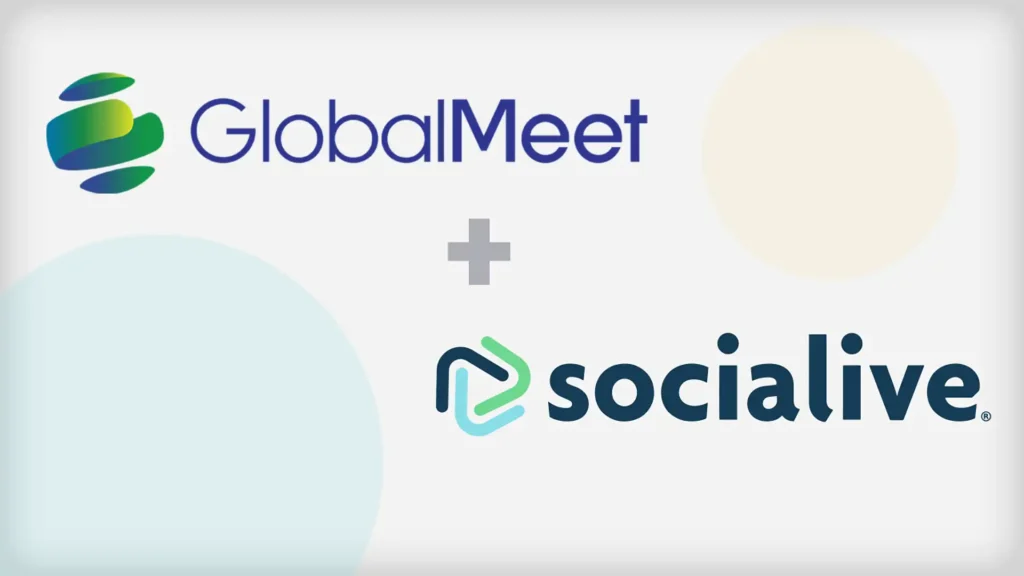
As a primarily relationship-driven business, financial services requires developing deep, personal connections with clients, prospects, and partners. To maintain these connections in an increasingly remote and hybrid world, many financial institutions have turned to video.
GlobalMeet partner Socialive surveyed 600+ professionals who work across wealth management, HR, learning and enablement, marketing and communications, and creative services departments at financial services organizations to better understand the growing trend of video content creation. We found that many teams have faced challenges creating videos remotely, as well as scaling their output due to process bottlenecks.
Download this report on the Transformation of Video in Financial Services to get insight on how you can meet the increasing demand and meet your bold video goals.
Please fill out the form below to access this content.

